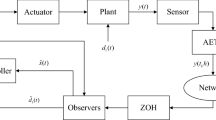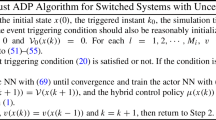Abstract
This paper is concerned with the dynamic event-triggered H∞ control issue of singularly perturbed switched systems, in which a persistent dwell-time switching regularity is embraced. The dynamic event-triggered mechanism is introduced to reduce some unnecessary data transmitted in the communication network so as to that the system can maintain the desired performance under better resource efficiency. Under this communication mechanism, a singular perturbation parameter independent criterion is derived to guarantee the globally uniform exponential stability with an H∞ performance for the considered persistent dwell-time switched singularly perturbed systems. Based on the criterion, a method is presented for calculating the gains of the desired controller. Finally, a numerical example is provided to verify the rationality and validity of the proposed method.
Similar content being viewed by others
References
J.-H. Li and T.-H. S. Li, “On the composite and reduced observer-based control of discrete two-time-scale systems,” Journal of the Franklin Institute, vol. 332, no. 1, pp. 47–66, January 1995.
H. Shen, M. Xing, H. Yan, and J. Cao, “Observer-based l2-l∞ control for singularly perturbed semi-Markov jump systems with improved weighted TOD protocol,” Science China Information Sciences, vol. 65, no. 9, 199204, June 2022.
J. Wang, C. Yang, J. Xia, Z.-G. Wu, and H. Shen, “Observer-based sliding mode control for networked fuzzy singularly perturbed systems under weighted try-once-discard protocol,” IEEE Transactions on Fuzzy Systems, vol. 30, no. 6, pp. 1889–1899, June 2022.
Y. Ji, H. Zhou, and Q. Gao, “Distributed containment control for multi-agent systems in pure-feedback form under switching topologies,” International Journal of Control, Automation, and Systems, vol. 16, no. 5, pp. 2312–2320, September 2018.
J. W. Kimball and P. T. Krein, “Singular perturbation theory for DC-DC converters and application to PFC converters,” IEEE Transactions on Power Electronics, vol. 23, no. 6, pp. 2970–2981, November 2008.
B. Siciliano, J. Prasad, and A. Calise, “Output feedback two-time scale control of multilink flexible arms,” Journal of Dynamics Systems, Measurement, and Control, vol. 114, no. 1, pp. 70–77, March 1992.
J. Cheong, W. K. Chung, and Y. Youm, “Inverse kinematics of multilink flexible robots for high-speed applications,” IEEE Transactions on Robotics and Automation, vol. 20, no. 2, pp. 269–282, April 2004.
I. Lizarraga and V. Etxebarria, “Combined PD-H∞ approach to control of flexible link manipulators using only directly measurable variables,” Cybernetics and Systems, vol. 34, no. 1, pp. 19–31, 2003.
J. B. Rejeb, I.-C. Morărescu, A. Girard, and J. Daafouz, “Stability analysis of a general class of singularly perturbed linear hybrid systems,” Automatica, vol. 90, pp. 98–108, April 2018.
J. Lian and X. Wang, “Exponential stabilization of singularly perturbed switched systems subject to actuator saturation,” Information Sciences, vol. 320, pp. 235–243, November 2015.
F. El Hachemi, M. Sigalotti, and J. Daafouz, “Stability analysis of singularly perturbed switched linear systems,” IEEE Transactions on Automatic Control, vol. 57, no. 8, pp. 2116–2121, August 2012.
M. S. Branicky, “Multiple lyapunov functions and other analysis tools for switched and hybrid systems,” IEEE Transactions on Automatic Control, vol. 43, no. 4, pp. 475–482, April 1998.
Z. Sun and S. S. Ge, Switched Linear Systems: Control and Design, Springer, New York, 2006.
L. Zhang, Y. Zhu, P. Shi, and Q. Lu, Time-Dependent Switched Discrete-Time Linear Systems: Control and Filtering, Springer, Cham, Switzerland, 2016.
A. S. Morse, “Supervisory control of families of linear setpoint controllers-Part 1. Exact matching,” IEEE Transactions on Automatic Control, vol. 41, no. 10, pp. 1413–1431, October 1996.
X. Zhao, L. Zhang, P. Shi, and M. Liu, “Stability and stabilization of switched linear systems with mode-dependent average dwell time,” IEEE Transactions on Automatic Control, vol. 57, no. 7, pp. 1809–1815, July 2012.
X. Zhao, L. Zhang, P. Shi, and M. Liu, “Stability of switched positive linear systems with average dwell time switching,” Automatica, vol. 48, no. 6, pp. 1132–1137, June 2012.
L. I. Allerhand and U. Shaked, “Robust state dependent switching of linear systems with dwell time,” IEEE Transactions on Automatic Control, vol. 58, no. 4, pp. 994–1001, April 2013.
J. Wen and L. Peng, “Switching predictive control for continuous-time Markovian jump delay systems,” International Journal of Control, Automation, and Systems, vol. 15, no. 3, pp. 1040–1050, May 2017.
J. P. Hespanha, “Uniform stability of switched linear systems: Extensions of Lasalle’s invariance principle,” IEEE Transactions on Automatic Control, vol. 49, no. 4, pp. 470–482, April 2004.
H. Shen, X. Hu, J. Wang, J. Cao, and W. Qian, “Non-fragile H∞ synchronization for Markov jump singularly perturbed coupled neural networks subject to double-layer switching regulation,” IEEE Transactions on Neural Networks and Learning Systems, vol. 34, no. 5, pp. 2682–2692, 2023.
X. Liu, J. Xia, J. Wang, and H. Shen, “Interval type-2 fuzzy passive filtering for nonlinear singularly perturbed PDT-switched systems and its application,” Journal of Systems Science and Complexity, vol. 34, no. 6, pp. 2195–2218, January 2021.
H. He, W. Qi, Z. Liu, and M. Wang, “Adaptive attack-resilient control for Markov jump system with additive attacks,” Nonlinear Dynamics, vol. 103, no. 2, pp. 1585–1598, January 2021.
S.-L. Dai and J. Zhao, “Reliable H∞ controller design for a class of uncertain linear systems with actuator failures,” International Journal of Control, Automation, and Systems, vol. 6, no. 6, pp. 954–959, December 2008.
Y. Shao, X. Jia, W. Liu, and G. Liu, “Adaptive stabilization of feedforward time-delay systems with uncertain output equation,” International Journal of Control, Automation, and Systems, vol. 20, no. 4, pp. 1194–1204, April 2022.
Y. Cui and L. Xu, “Networked control for linear systems with forward and backward channels in presence of data transmission delays, consecutive packet dropouts and disordering,” Journal of the Franklin Institute, vol. 358, no. 8, pp. 4121–4140, May 2021.
J. Zhang, S. Li, C. K. Ahn, and Z. Xiang, “Decentralized event-triggered adaptive fuzzy control for nonlinear switched large-scale systems with input delay via command-filtered backstepping,” IEEE Transactions on Fuzzy Systems, vol. 30, no. 6, pp. 2118–2123, June 2022.
M. Li, S. Li, C. K. Ahn, and Z. Xiang, “Adaptive fuzzy event-triggered command-filtered control for nonlinear time-delay systems,” IEEE Transactions on Fuzzy Systems, vol. 30, no. 4, pp. 1025–1035, April 2022.
Z. Gu, P. Shi, and D. Yue, “An adaptive event-triggering scheme for networked interconnected control system with stochastic uncertainty,” International Journal of Robust and Nonlinear Control, vol. 27, no. 2, pp. 236–251, May 2017.
H. Wang, Y. Wang, and G. Zhuang, “Asynchronous H∞ controller design for neutral singular Markov jump systems under dynamic event-triggered schemes,” Journal of the Franklin Institute, vol. 358, no. 1, pp. 494–515, January 2021.
Y. Li, X. Liu, H. Liu, C. Du, and P. Lu, “Distributed dynamic event-triggered consensus control for multi-agent systems under fixed and switching topologies,” Journal of the Franklin Institute, vol. 358, no. 8, pp. 4348–4372, May 2021.
Z. Cao, Y. Niu, H.-K. Lam, and J. Zhao, “Sliding mode control of Markovian jump fuzzy systems: A dynamic event-triggered method,” IEEE Transactions on Fuzzy Systems, vol. 29, no. 10, pp. 2902–2915, October 2021.
X. Ge, Q.-L. Han, and Z. Wang, “A dynamic event-triggered transmission scheme for distributed set-membership estimation over wireless sensor networks,” IEEE Transactions on Cybernetics, vol. 49, no. 1, pp. 171–183, January 2019.
X. Sun, D. Yang, and G. Zong, “Annular finite-time H∞ control of switched fuzzy systems: A switching dynamic event-triggered control approach,” Nonlinear Analysis: Hybrid Systems, vol. 41, p. 101050, August 2021.
J. Wang, Z. Huang, Z. Wu, J. Cao, and H. Shen, “Extended dissipative control for singularly perturbed PDT switched systems and its application,” IEEE Transactions on Circuits and Systems I: Regular Papers, vol. 67, no. 12, pp. 5281–5289, December 2020.
J. Wang, J. Xia, H. Shen, M. Xing, and J. H. Park, “H∞ synchronization for fuzzy Markov jump chaotic systems with piecewise-constant transition probabilities subject to PDT switching rule,” IEEE Transactions on Fuzzy Systems, vol. 29, no. 10, pp. 3082–3092, October 2021.
Author information
Authors and Affiliations
Corresponding authors
Ethics declarations
The authors declare that there is no competing financial interest or personal relationship that could have appeared to influence the work reported in this paper.
Additional information
Publisher’s Note Springer Nature remains neutral with regard to jurisdictional claims in published maps and institutional affiliations.
This work was supported by the National Natural Science Foundation of China under Grant 62273006, 62173001, 62303016; the Major Technologies Research and Development Special Program of Anhui Province under Grant 202003a05020001; the Key research and development projects of Anhui Province under Grant 202104a05020015, the Natural Science Foundation for Distinguished Young Scholars of Higher Education Institutions of Anhui Province under grant 2022AH020034, the Natural Science Foundation for Excellent Young Scholars of Higher Education Institutions of Anhui Province under grant 2022AH030049.
Yinsheng Song is now an M.S. candidate at the School of Electrical and Information Engineering, Anhui University of Technology, China. His current research interests include singularly perturbed systems, switched systems, and event-triggered mechanism.
Guanqi Wang is now an M.S. candidate at the School of Electrical and Information Engineering, Anhui University of Technology, China. His current research interests include singular systems, Markov jump systems, and robust control and filtering.
Feng Li received his M.S. degree in electrical engineering from Anhui University of Technology, Ma’anshan, China, in 2017, and a Ph.D. degree in control science and engineering from Nanjing University of Science and Technology, Nanjing, China, in 2021. He is currently a Lecturer with the School of Electrical and Information Engineering, Anhui University of Technology, Ma’anshan, China. From April 2019 to November 2020, he was a Visiting Fellow with the School of Computer, Data and Mathematical Sciences, Western Sydney University, Sydney, NSW, Australia. His current research interests include Markov jump systems, singularly perturbed systems, neural networks, networked control systems, robust control and filtering, and their applications.
Hao Shen received his Ph.D. degree in control theory and control engineering from Nanjing University of Science and Technology, Nanjing, China, in 2011. From February 2013 to March 2014, he was a Post-Doctoral Fellow with the Department of Electrical Engineering, Yeungnam University, Korea. Since 2011, he has been with Anhui University of Technology, China, where he is currently a Professor and a Doctoral Supervisor. His current research interests include stochastic hybrid systems, complex networks, fuzzy systems and control, and nonlinear control. Prof. Shen was a recipient of the Highly Cited Researcher Award by Clarivate Analytics (formerly, Thomson Reuters) in 2019–2021.
Jing Wang received her Ph.D. degree in electric power system and automation from Hohai University in 2019. Since 2011, she has been with Anhui University of Technology, China, where she is currently an Associate Professor. Her current research interests include nonlinear control, complex networks, and power systems.
Rights and permissions
About this article
Cite this article
Song, Y., Wang, G., Li, F. et al. Dynamic Event-triggered H∞ Control for Singularly Perturbed Switched Systems Under Persistent Dwell-time. Int. J. Control Autom. Syst. 21, 3239–3248 (2023). https://doi.org/10.1007/s12555-022-0763-7
Received:
Revised:
Accepted:
Published:
Issue Date:
DOI: https://doi.org/10.1007/s12555-022-0763-7




